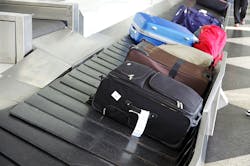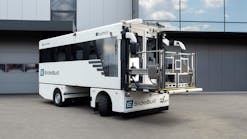While passengers travel by air across the globe, airports, airlines and ground handlers go to great lengths to make sure those customers’ checked baggage makes the same journey.
SITA introduced its BagJourney system to make sure everyone involved in the process has up-to-date information about the location of each piece of baggage being handled.
“BagJourney is a repository of all baggage handling events. You can see anything that happens to the bag – from check-in all the way to delivery of that bag to the passenger,” says Peter Drummond, baggage portfolio director at SITA.
Typically, when a traveler checks a bag, and that piece of luggage is tagged with a barcode, it passes through multiple points before reaching the desired aircraft.
As it moves through the departure control system to the baggage handling system, gets routed to the loading carousel and placed in the aircraft hold, the bag’s tag is scanned multiple times and a message is sent through a message distribution service or via a direct connection. The last scan is done by a ground handling agent.
“He’ll scan the tag and the computer will tell him whether or not that bag for that passenger is on a particular aircraft,” explains Drummond. “If it gets an OK, that bag goes onto a cart and that bag is then sent to the aircraft out on the ramp.”
At each of those scans, each system can send a baggage process message that is delivered to the airline.
BagJourney came about because SITA saw a desire for passengers to track their baggage.
“That was primarily our use case for the origin of BagJourney. We had a great system in place in message distribution called BagMessage. BagMessage distributes messages from airlines to airports, and from airports back to airlines,” Drummond says. “We thought, ‘Wouldn’t it be great if we could do something with that data? Maybe we could add some value to it and give it back to airlines to enable passengers to get a live update on the status of their bags.’
“BagJourney is taking existing technology, and then reading those messages, applying some business logic to them to define some identifiable statuses and then presenting that in a manner that enables airlines to integrate this with their apps,” he adds.
BagJourney was created before the International Air Transport Association (IATA) passed Resolution 753, requiring IATA members to maintain an accurate inventory of baggage by monitoring the acquisition and delivery of each bag.
However many of BagJourney’s features help airlines become compliant with Resolution 753 because the system allows SITA’s customers to demonstrate a bag has been loaded into an aircraft, transferred to another airline, delivered to the passenger, etc.
“We thought this is a great opportunity for BagJourney. Out of the box, airlines and airports could become IATA compliant by using this back-end environment,” Drummond says. “It’s mainly geared at airports or airlines that don’t have access to IT systems – big IT infrastructures.”
BagJourney can also provide assistance if a passenger’s baggage doesn’t make it onto the aircraft correctly because it works with SITA’s WorldTracer system that tracks mishandled luggage.
Additionally, BagJourney can be integrated into cabin crew information services, so that if a passengers’ bag is mishandled, an airline can process the passenger aboard the aircraft.
“In fact, you can do service recovery aboard the aircraft before the passenger even realizes their bag has been mishandled,” Drummond notes.
“The passenger can just go home without having to worry about collecting the bag or being agitated about that bag not arriving,” he continues, noting it can often take up to 30 minutes for passenger to realize their bag didn’t arrive at their destination and then they have to begin filing a report with the airline. “The whole experience of that flight is going to be ruined by the arrival process. So you can process them aboard the aircraft, and you can even upgrade them while they’re on board the aircraft.”
What’s more, the information provided by BagJourney can be used further for proration when a bag is mishandled and doesn’t arrive at a passenger’s destination.
“The airlines prorate the cost back to each individual airline based upon who’s at fault. By knowing, and seeing, where that bag has been touched, you can see who is at fault with more ease,” explains Drummond. “It’s easier to align the cost.”
Pointing out that large airlines often have their own baggage-tracking devices, Drummond says their primary customers are often smaller airlines.
“This is really a service that we could offer to smaller airlines or smaller airports to track bags much more easily,” he says, adding the Etihad Group uses BagJourney.
Going forward, SITA intends to build additional capabilities into the BagJourney to enable airlines to add more tracking points that could provide additional data to help various systems communicate effectively.
“At an airport, you may already have a baggage handling system that’s already in place, and you may have a baggage reconciliation system that’s already in place – two separate systems sold and run by two different organizations and managed by maybe multiple IT vendors,” Drummond says. “So with BagJourney, the great thing about being in the cloud, you can build a data capture point at an arrival belt that connects directly to the internet, inputs that data into BagJourney and then we can share that data with those existing services at an airport.
“It’s information that’s already passing through the systems shared by the different entities, and then providing it back to those same entities in a more identifiable way,” he concludes.







